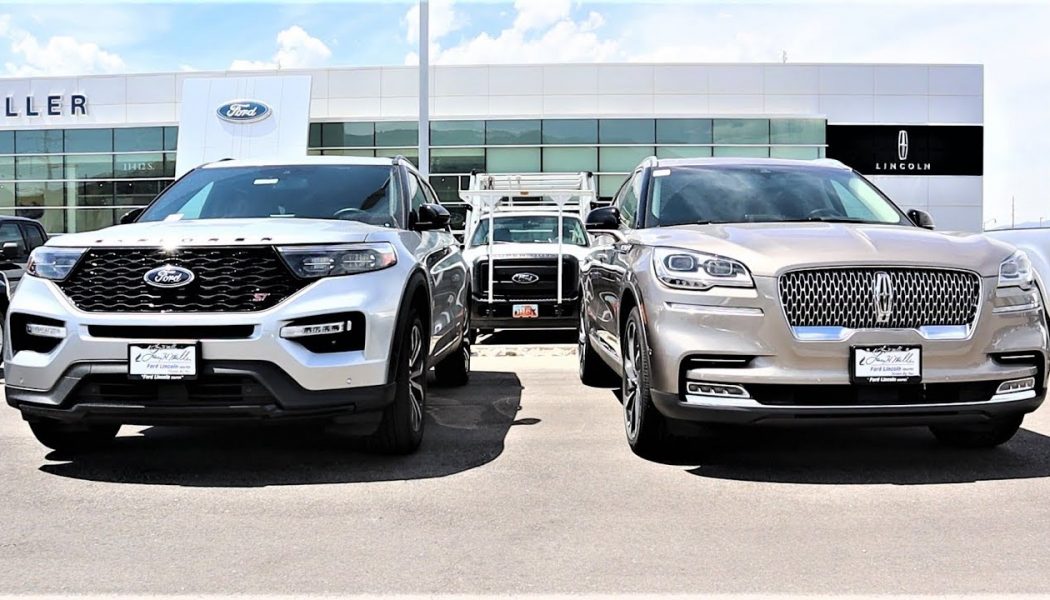Today’s customers expect vehicles to offer confident performance and a spacious and comfortable interior with the latest technologies, no matter whether it’s a mainstream or luxury car. Ford and Lincoln have brought the goods to their respective three-row SUVs debuting for 2020. But is the Lincoln Aviator really worth the big price premium over its mainstream sibling, the Ford Explorer? Find out how the two vehicles stack up in our 2020 Ford Explorer vs. 2020 Lincoln Aviator comparison.
Which Has More Interior Space?
Overall, both SUVs are spacious. Accessing the third row is easy since the seats in the second row move forward with the push of a button. Once you’ve reached the back row, space is rather tight, but that’s a typical complaint for the three-row SUV segment.
The Explorer wins in a few key metrics when it comes to interior space. It offers more cargo space behind the first and second rows. Behind the third row, the SUVs provide about the same amount of room for your gear.
The SUVs also provide similar amounts of legroom behind the second row. The Explorer has a small advantage when it comes to third-row legroom, however.
Cargo space (cubic feet) (Explorer/Aviator)
Behind the first row: 87.8/77.7
Behind the second row: 47.9/41.8
Behind the third row: 18.2/18.3
Legroom (inches) (Explorer/Aviator)
Second row: 39/40.1
Third row: 32.2/29.2
Which Has More Features and Technologies?
Yes, it’s a mainstream SUV, but the Explorer has a solid list of standard features. These include cloth seats, tri-zone climate control, a power liftgate, an 8-inch touchscreen, and Wi-Fi for up to 10 devices. Available features include a 10.1-inch touchscreen, leather seats, power fold third row, wireless charging, and a foot-activated tailgate. Opt for the terrain management system if you want some extra help tackling snow, sand, and slippery roads. If you go for the fanciest Platinum model, you get a twin-panel moonroof, a 12-inch digital instrument cluster, and diamond perforated leather upholstery.
Of course, the Aviator ups the ante significantly. In base form, the 10.1-inch touchscreen is standard, along with leatherette seats with heating up front and a power folding third row. Mid-grade models are luxurious, but the Black Label is particularly supple. Black Label models utilize the softest leather and offer a variety of expressive design themes. These models also come with 30-way adjustable seats with massage capability, heated and ventilated first and second row seats, a head-up display, soft close doors, and a 28-speaker sound system.
It may be unfair to compare features on these two SUVs since they have very different price points (which we discuss below). But we’ll call this a win for the Aviator because of its overall fit and finish. The Explorer’s interior feels cheaper than it should for the price thanks to Ford’s use of dull plastics and low-quality leather. On the other hand, the Aviator has a supremely luxurious cabin.
Which Has Better Performance?
Usually, three-row SUV buyers don’t expect scintillating performance. But the Explorer and Aviator are surprisingly fun to drive despite their size and heavy weight.
Powerful engines help. The Explorer comes standard with a four-cylinder engine, and it’s a powerful and torquey one, making 300 hp and 310 lb-ft. On the Hybrid variant, a V-6 pairs seamlessly with an electric motor to deliver 318 hp and 322 lb-ft of torque smoothly. The next most powerful variant makes 365 hp and 380 lb-ft of torque from a twin-turbo V-6 engine. Finally, a performance-minded ST variant pumps up the volume on that engine to produce 400 hp and 415 lb-ft. This is the quickest Explorer, hitting 60 mph in 5.3 seconds compared to 6.8 seconds for the base engine and 7.7 seconds for the hybrid. The ST benefits from sharper steering and throttle response than other Explorers, but suffers from jarring brakes.
Despite not having a designated performance variant, the Aviator is quicker. We’ve clocked both the standard and the heavier plug-in hybrid variants zipping to 60 mph in 5.4 seconds. A twin-turbo V-6 delivers 400 hp and 415 lb-ft of torque, while the plug-in version adds an electric system bringing total output to 494 hp. In past reviews, we’ve praised the Aviator’s supple suspension that protects occupants from bumps in the road. However, we’re a little unnerved by the plug-in model’s aggressive throttle tip-in.
Which Is More Efficient?
Powerful and efficient, the hybrid Explorer maxes out at 28 mpg in combined city and highway driving. The four-cylinder Explorer also gives a solid performance, delivering up to 24 mpg. With the twin-turbo V-6, fuel economy drops to 20 mpg.
The Lincoln Aviator has an edge in the MPG category because of its available plug-in hybrid drivetrain, topping out at 56 MPGe. The standard Aviator nets 21 mpg.
Which Is Safer?
Which is the safer SUV: the Explorer or the Aviator? Well, it’s a toss-up. Both models come standard with a bevy of safety features. These include pre-collision assist with automatic emergency braking, blind-spot information system with cross-traffic alert, lane keeping assist, and automatic headlamps with auto high beams. An available feature on both SUVs, evasive steering assist provides steering support to help avoid collisions.
Neither the Aviator nor the Explorer is ranked a Top Safety Pick from the Insurance Institute for Highway Safety. Both models earned “Good” scores in all crash categories tested except for the small overlap test, which replicates what happens when the front left corner of the car hits an object. In this category, both SUVs earned an “Acceptable” score. Upgraded Aviators have “Good”-rated headlights, while other models have headlights that are rated “Marginal.” IIHS rates the headlights on the Explorer as “Acceptable.”
In government tests, the Ford and Lincoln earned the same crash scores. Both models get five stars overall, which breaks down to five stars in the front crash test, five stars in the side crash test, and four stars in the rollover test. The government has not yet rated the Aviator plug-in variant.
Which Is More Expensive?
As you might imagine, the Ford Explorer is considerably less expensive than the Lincoln Aviator. Prices start at $34,010 for the Blue Oval SUV. Those who choose the hybrid Explorer will pay at least $53,525, while the sporty ST is just a little more costly at $55,985. The top-of-the-line Platinum model starts at $59,495.
The 2020 Lincoln Aviator starts at $52,195 for the base model. Upgrade to the plug-in hybrid, and the price jumps to $69,895. The most expensive Aviator you can buy is the Black Label Grand Touring with the plug-in hybrid powertrain. Expect to pay at least $88,895 for these models.
2020 Ford Explorer vs. 2020 Lincoln Aviator: Which Should You Buy?
More Videos
By now, you’ve learned the Aviator is not a gussied-up Explorer. It’s the no-brainer choice if you’re looking for an SUV with a luxurious interior and a very plush ride. The Aviator also benefits from stronger acceleration, so if you want to be first off the line when merging on the freeway, this is your pick.
The Explorer has its merits, however. Not everyone wants to spend more than $50,000 on a three-row SUV. Buyers looking for good fuel economy without the hassle of a plug may also want to consider the hybrid Explorer. The Blue Oval SUV also benefits from slightly more interior space than the Aviator.










